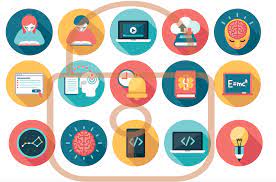Educational Resources: Enhancing Learning Opportunities
Educational resources play a crucial role in providing students with the tools and materials they need to succeed in their academic journey. From textbooks and online courses to interactive learning platforms and multimedia resources, the availability of educational materials has greatly expanded in recent years, offering students a wealth of opportunities to enhance their knowledge and skills.
One of the key benefits of educational resources is their ability to cater to diverse learning styles and preferences. Visual learners may benefit from videos and infographics, while auditory learners may prefer podcasts and audio lectures. Interactive simulations and games can engage kinesthetic learners, providing a hands-on approach to learning.
Furthermore, educational resources can help bridge the gap between traditional classroom instruction and self-directed learning. Online platforms offer flexibility and accessibility, allowing students to learn at their own pace and revisit concepts as needed. This personalised approach can boost student engagement and retention, leading to improved academic performance.
Technology has revolutionised the way educational resources are accessed and utilised. With the rise of e-books, virtual classrooms, and online tutoring services, students now have a wealth of information at their fingertips. This digital transformation has made learning more interactive, collaborative, and engaging than ever before.
In addition to benefiting students, educational resources also support educators in enhancing their teaching practices. Teachers can leverage online lesson plans, instructional videos, and assessment tools to create dynamic and engaging learning experiences for their students. By incorporating a variety of resources into their curriculum, educators can cater to different learning styles and abilities, fostering a more inclusive classroom environment.
In conclusion, educational resources play a vital role in enriching the learning experience for students of all ages. By embracing the diverse range of materials available today, students can explore new subjects, develop critical thinking skills, and ultimately achieve academic success.
Understanding Educational Resources: Key Concepts and Common Inquiries
- What makes a good educational resource?
- What is digital learning resources?
- What is a resource in education?
- What are examples of instructional materials?
- What do you mean by educational resources?
- What are the different types of learning resources used in teaching education?
What makes a good educational resource?
When considering what makes a good educational resource, several key factors come into play. Firstly, relevance is crucial – a good educational resource should align with the curriculum or learning objectives, providing accurate and up-to-date information. Additionally, accessibility is important to ensure that students of all backgrounds and abilities can benefit from the resource. Interactivity and engagement also play a significant role, as resources that are interactive and engaging can enhance student motivation and understanding. Finally, adaptability is key – a good educational resource should be adaptable to different learning styles and preferences, allowing for personalised learning experiences that cater to individual needs.
What is digital learning resources?
Digital learning resources refer to educational materials and tools that are accessed and utilised through digital platforms such as websites, apps, and online databases. These resources encompass a wide range of digital content, including e-books, interactive modules, videos, simulations, and quizzes. Digital learning resources offer students the flexibility to learn anytime, anywhere, using devices such as computers, tablets, and smartphones. By leveraging technology to deliver engaging and interactive content, digital learning resources enhance the learning experience by catering to diverse learning styles and preferences.
What is a resource in education?
In the realm of education, a resource is a fundamental tool or asset that educators utilise to facilitate learning and enhance the educational experience for students. These resources can take various forms, such as textbooks, online materials, visual aids, technology tools, and hands-on activities. Essentially, a resource in education serves as a means to convey information, stimulate critical thinking, and support the acquisition of knowledge and skills. By incorporating diverse resources into teaching practices, educators can cater to different learning styles and engage students in meaningful ways, fostering a dynamic and enriching learning environment.
What are examples of instructional materials?
Instructional materials encompass a wide range of resources that support teaching and learning processes. Examples of instructional materials include textbooks, workbooks, multimedia presentations, educational games, worksheets, visual aids such as charts and graphs, laboratory equipment for science experiments, online resources like videos and interactive simulations, and more. These materials are designed to enhance the delivery of educational content, engage students in active learning, and facilitate comprehension and retention of information across various subjects and disciplines. By utilising a variety of instructional materials, educators can cater to different learning styles and preferences, making the learning experience more dynamic and effective for students.
What do you mean by educational resources?
Educational resources refer to a wide range of tools, materials, and sources of information that are designed to support learning and enhance educational experiences. These resources can include textbooks, online courses, multimedia presentations, interactive simulations, and more. Essentially, educational resources are any resource that aids in the acquisition of knowledge and skills, helping students to better understand concepts, reinforce learning, and engage with course material in a meaningful way. By providing access to diverse and relevant educational materials, these resources play a crucial role in facilitating effective teaching and learning processes across various subjects and disciplines.
What are the different types of learning resources used in teaching education?
In the field of teaching education, various types of learning resources are utilised to enhance the learning experience for students. These resources encompass a wide range of materials, including textbooks, multimedia presentations, online courses, interactive simulations, educational games, and hands-on activities. Each type of resource serves a unique purpose in catering to different learning styles and preferences, providing educators with versatile tools to engage students and facilitate effective learning. By incorporating a diverse array of learning resources into their teaching practices, educators can create dynamic and interactive lessons that inspire curiosity, foster critical thinking skills, and promote academic success among their students.

Leave a Reply